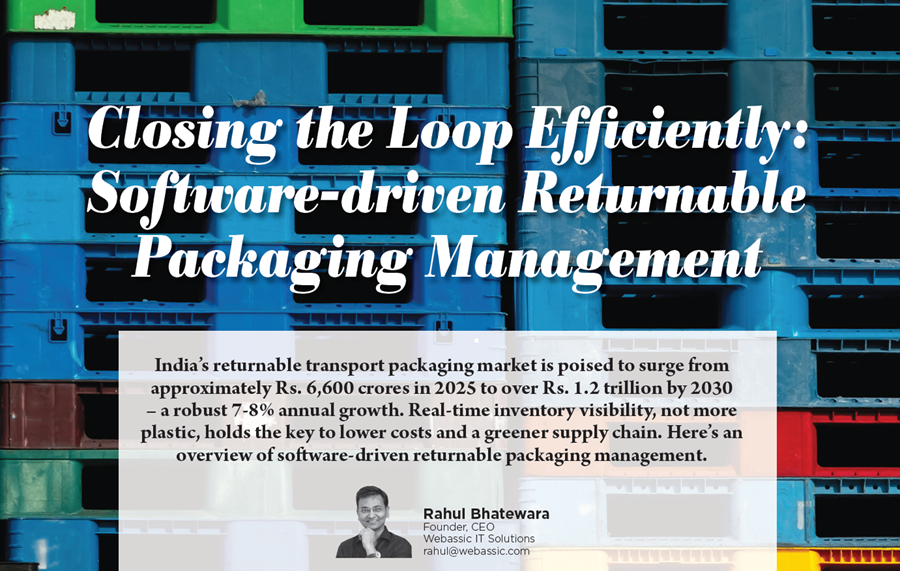India’s returnable transport packaging market is poised to surge from approximately Rs. 6,600 crores in 2025 to over Rs. 1.2 trillion by 2030 – a robust 7-8% annual growth. Real-time inventory visibility, not more plastic, holds the key to lower costs and a greener supply chain. Here’s an overview of software-driven returnable packaging management.
Crates, pallets, sleeves, and totes are the silent workhorses of modern manufacturing. Re-used dozens—sometimes hundreds—of times, they promise both cost and environmental benefits over single-use cardboard. Yet the practical reality is messier: once these assets leave the dispatch gate, many businesses track them with a patchwork of spreadsheets, phone calls, and end-of-month reconciliations. Miscounts creep in, cycle times stretch, and capital quietly drains away as “missing” containers are written off or replaced.
The scale of the problem is growing. India’s market for returnable transport packaging is projected to rise from about ₹6,600 crore in 2025 to well over ₹1.2 trillion by 2030, expanding at roughly 7–8 percent a year. As volumes rise, even a modest loss rate can translate into crores of rupees in avoidable expense—money that could fund innovation instead of idle plastic. At the same time, customers and regulators alike are demanding clearer data on waste and carbon footprints. Simply put, “I’ll check the spreadsheet later” is no longer good enough.
Recognising this gap, Webassic IT Solutions built a lightweight Returnable Packaging Management System (RPMS) that treats each dispatch and receipt as an inventory movement—no specialised RFID or QR tags required. By focusing on accurate, event-based postings rather than high-tech hardware, the platform offers manufacturers an affordable first step toward true packaging circularity. This article explores the pain points RPMS addresses, the design principles behind it, and implementation lessons that any logistics team can apply
1 | Why Returnable Packaging Goes Missing in Action
Visibility gaps. Once containers leave the supplier’s yard, confirmation of receipt may not appear until a month-end tally, if at all. Ageing empties sit forgotten in customers’ warehouses. Complex journeys. Automotive, FMCG, and electronics supply chains often involve two or three tiers of partners. Each hand-off introduces another chance for paperwork to diverge from reality. Capital lock-up. A mid-size component maker rotating 15,000 crates worth ₹12 crore will lose nearly ₹75 lakh a year if just 5 percent vanish. Multiply that across India’s supply chains and the national bill runs into thousands of crores. ESG blind spots. Without reliable counts, it is hard to prove reductions in single-use packaging or Scope-3 emissions—data increasingly required by exporters and investors.
2 | A Movement-Based Approach to Tracking
Webassic’s RPMS focuses on one deceptively simple question: “Where is my packaging right now?” Key features include:
- Real-time inventory dashboard – Dispatch, in-transit, with customer, under repair, and back-in-store counts update the moment a gate clerk posts a transaction.
- Automated workflows – Material requests, delivery challans, e-way-bill references, and return alerts all follow configurable business rules, trimming manual effort and errors.
- Unlimited users and records – No per-seat fees mean everyone—security guards, warehouse supervisors, accounts—works off the same data set.
- ERP-agnostic integration – REST APIs and flat-file connectors push postings to SAP, Tally, or a simple spreadsheet, so IT teams avoid “rip and replace” upheavals.
- Cost-and-carbon analytics – By comparing planned versus actual cycle times, managers can see how many extra containers they carry—and how much CO₂ they could avoid by rotating stock faster.
A field example. An auto-ancillary in Pune piloted RPMS on 8,000 plastic crates moving between two plants and five OEM customers. Within three months:
- Average crate turnaround fell from 17 days to 10.5 days.
- “Where-is-it?” ticket volume dropped 60 percent because staff trusted the live dashboard.
- Working capital tied up in spare packaging fell by roughly ₹45 lakh.
No QR tags or GPS devices were added; benefits came purely from disciplined event posting at dispatch and receipt.
3 | Implementation Lessons & Future Outlook
Start with the process, not the software. Map current touchpoints—who creates a delivery challan, who signs off return receipts, when does inventory post? Align RPMS screens to that reality before chasing automation.
Make data entry effortless. On rugged tablets, the platform auto-fills customer and container type once a delivery challan number is scanned. Less typing equals fewer errors and higher adoption.
Treat returns like outbound dispatches. Many organisations track sales shipments meticulously but treat empties as an afterthought. Requiring a mirror transaction for returns closes the loop.
Focus on the “aging” report. A simple list of containers idle past the agreed service-level turns conversations with customers from blame games into joint problem solving.
Looking ahead, Webassic is exploring optional NFC tagging for high-value metal racks and predictive analytics that forecast when a site will run short of empties. But the core principle will stay the same: low-friction data capture first, fancy hardware later.
Returnable packaging pays for itself only when it returns. Yet across India, millions of containers drift in limbo because traditional tracking methods can’t match today’s supply-chain speed. An event-based software layer that records each movement in real time offers a pragmatic remedy—delivering sharper visibility, leaner working capital, and credible ESG metrics without the cost of specialised tags.
Webassic’s RPMS demonstrates that such a layer need not be expensive or complex. By emphasising flexible workflows, open integrations, and unlimited user access, the platform allows businesses of any size to gain control over their crate and pallet pools. More important, it shows that the road to circular logistics begins with something every team can manage today: accurate, shared data.
For operations leaders wondering where their next batch of empties is hiding—or finance teams eyeing the silent cost of lost packaging—the message is clear: start tracking every movement, and the savings will follow.
Learn More
Explore a detailed feature tour, customer stories, and demo videos at https://webassic.com/it-solutions/returnable-packaging-management
